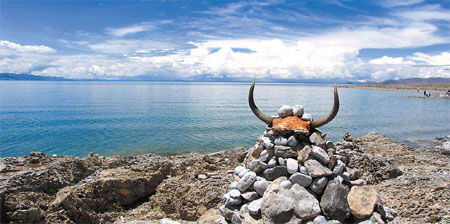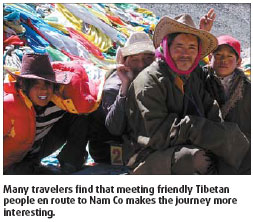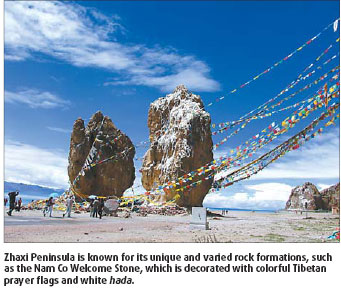The cost of making a trip to Nam Co Lake in the Tibet Autonomous Region was high, not fiscally but physically. The altitude of the glamorous spot is 4,718 meters above sea level. My companions and I all suffered from altitude sickness, which had gradually drained the excitements from us before we got there.
Mani stones, usually with an ox horn on the top, meant to represent prayers, can be found all around the banks of Nam Co.
Making matters worse, a storm was coming, and the sky became brown like mud. In a matter of seconds the lake disappeared under a curtain of rain.
We were sent to Zhaxi Peninsula, one of the main tourism spots around the lake.
Various tents providing food, drinks and even accommodation dotted the entrance of the peninsula. However, all of them are temporary and only turn up from May to October every year, just before winter comes.
We took shelter in the Sisters' Sweet Teahouse. Actually, the so-called teahouse of no more than 10 square meters seemed too crowded for six of us.
Rather than ordering drinks first, we could not wait to dry our clothes by standing around a stove attached with a metal pipe to the ceiling.
The owners, two young Tibetan girls, went out and brought back more fuel - dried cow dung.
One girl broke them off, as if nipping off biscuits, then threw the pieces in the stove. After that, she rubbed her hands on the apron for few times and continued making beef-stuffing dumplings next to me, with the price of half yuan for each.
Even though I was famished, I didn't dare try a single dumpling after seeing how they were prepared. I kept drinking sweet tea instead.
It tasted like black tea. The only difference between them is that Tibetan people add powdered milk to the tea if fresh milk is not available.
If you are not accustomed to buttered tea, the classic drink in Tibet, sweet tea is a good option to boost your energy, especially at the unbelievably cheap price of 2 yuan (15 US cents) per bottle.
We could have stayed in the teahouse the whole day, drinking and chatting, as local people normally do to kill time.
However, after noticing that the ceiling had turned much brighter, we walked out the tent and unexpectedly stepped into a new world - Nam Co Lake surrounded by endless mountains sparkles like a huge blue diamond within walking distance.
Nam Co, which means "Lake of Heaven" in the Tibetan language, is more than two hours' drive from Lhasa, the capital city of the Tibet Autonomous Region. It is a saltwater lake with the highest altitudes in the world.
With an area of 1,940 square kilometers, it tops the first of the three most famous lakes in Tibet and is also a key site of Tibetan Buddhism.
The year of the Sheep in the Tibetan calendar is the birthday of Nam Co. When it comes, thousands of disciples walk around the lake to pray for peace and happiness. This explains why only those who were born in the year of the Sheep can pick up stones from the lake, while others are not allowed to do because it will bring bad luck.
I was a bit disappointed when we reached the lakeside, because it seemed more like a crowded beach due to the number of tourists.
Suolang Duojie, a Tibetan man who volunteered to be our guide, suggested going to the back of Zhaxi Peninsula, which also has stunning landscapes but fewer people.
"But we have to walk clockwise because it is a tradition," the 20-year-old stressed.
We often stopped to shoot photos, and the water was so tempting that we could not resist touching it.
What's more magical was its color - clear green up close that gradually darkened to navy blue on the horizon.
One tourist took off his clothes and was about to jump into the water, but he was stopped by his guide, because swimming is not allowed in such a holy lake.
There are no permanent residents along the lakeside. Only the world-famous snow mountain Nyenchen Tanglha stands beside it, with an altitude of more than 7,000 meters above sea level.
According to a Tibetan legend, Nyenchen Tanglha and Nam Co are not just a famous divine mountain and a lake, but also lovers; one is like a god wearing a suit of snow-white armor, the other a beautiful fairy.
They have been beside each other for more than 70 million years, according to geological research.
There is a great number of mani stones piled along the banks, each pile more than a half-meter tall. Suolang explained they were made by disciples, each stone representing one wish. The taller the stones pile up, the better luck they will have.
To show their respect, people place either ox horns or hada (long pieces of silk used as a greeting gift in Tibet) on top of the piles.
There are a number of caves along the peninsula, and the Good and Evil Cave is a must-visit place. According to legend, only a good person can climb through the tiny hole, no matter how big his or her body is.
I didn't want to try at first, because in my case, it seemed like squeezing a camel into a fridge.
After all of my companions made it through, I realized that I didn't have any choice but to give it a go.
When I eventually managed to get out the cave, the crowd erupted with applause.
It took us more than three hours to complete the journey. This made me realized that Nam Co is definitely a place you have to visit more than once.
(China Daily August 30, 2007)




